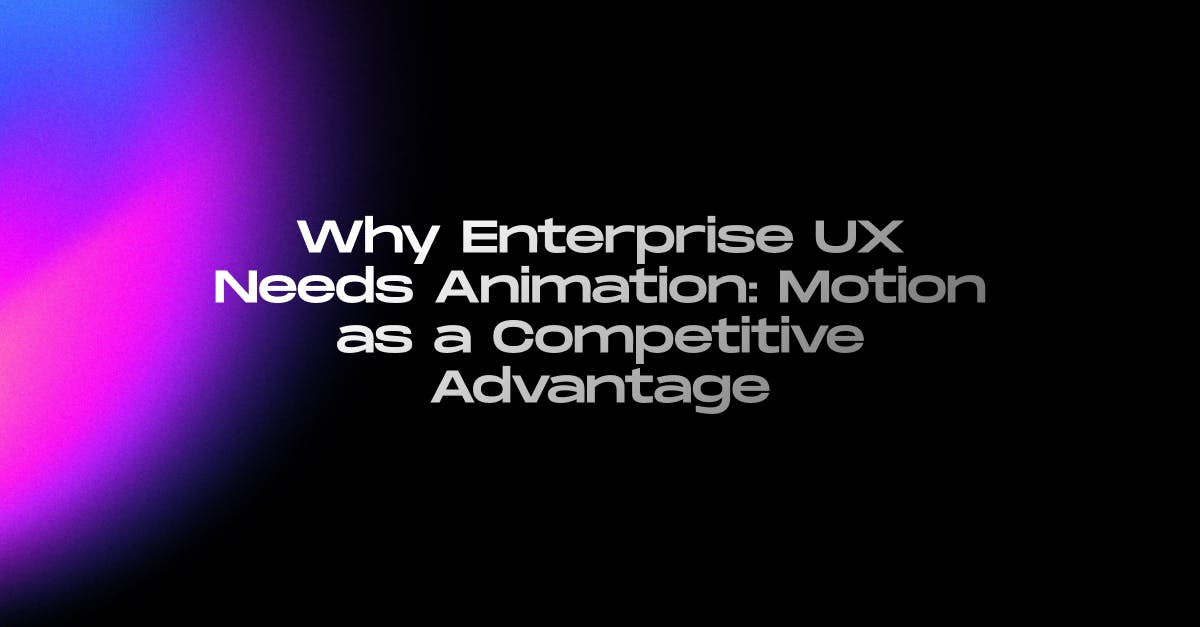October 30, 2025
Why Enterprise UX Needs Animation: Motion as a Competitive Advantage

Md. Saad

You might imagine consumer-focused e-commerce experiences, marketing websites, or entertaining apps when you think of animation in digital products. However, animation has a far more strategic function, especially in enterprise user experience. Motion is more than just visual appeal for enterprise solutions, which are often mission-critical, thick, and data-heavy. It fosters trust, clarity, and productivity.
Mobility becomes a competitive advantage in settings where user satisfaction, software adoption, and efficiency all directly impact business outcomes.
The Challenge of Enterprise UX
Enterprise platforms differ from consumer apps in one important respect: complexity.
- A typical enterprise user manages several dashboards, integrations, and modules.
- Workflows are frequently multi-step processes that require departmental collaboration.
- Users range from CEOs seeking high-level insights to analysts need granular control.
Without proper design, these systems can be overwhelming—even terrifying. That's where motion comes in: not as decoration, but as a practical layer of design that directs users, eliminates friction, and boosts adoption.
1. Motion Provides Clarity in Complex Workflows
Processes like data migrations, sales pipelines, and compliance approvals can be complicated and confusing when managed by business software. Motion makes things easier by providing users with a visual story.
- Guided navigation: Users are persuaded they are headed in the right direction by animations that seamlessly move between process steps. Transitions visually link "where I was" to "where I am," as opposed to appearing suddenly on a new screen.
- Microinteractions: Instant feedback is provided by subtle animations on form fields, such as shaking on error or shining on success.
- Hierarchical indicators: Collapsing/expanding panels that are animated effectively show parent-child relationships between data sets.
Motion reduces cognitive load, which is why it matters. The interface conveys what has just happened intuitively, rather than requiring users to think about it.
2. Motion Enhances Efficiency and Reduces Errors
Enterprise users usually have deadlines to meet, like finishing a quarter, analysing real-time operations, or addressing customer grievances. Every second matters. Motion is beneficial in two significant ways:
- Faster feature discovery: Without requiring extra clicks, hover animations on buttons or icons help users comprehend functionality.
- Visual continuity: It is simpler to comprehend a row that slides open to reveal details than a modal that breaks the scene.
- Premature clicks, repetitive actions, and frustration are decreased when loading animations with progress feedback alerting users that the system is processing.
Why it's important Motion ensures that enterprise solutions support productivity rather than impede it, improves job completion rates, and lowers error rates.
3. Motion Builds Trust and Perceived Reliability
With multi-million dollar rollouts across multinational corporations, enterprise software entails substantial investments. The reliability and future-proofness of the system must be guaranteed to buyers and end users.
Consistent motion patterns, graceful transitions, and fluid animations convey:
- Stability: The system seems deliberate rather than hurried or unreliable.
- Customers think that if the small details are well-executed, the main product is reliable.
- Modernity: mobility denotes innovation; stiff, outdated interfaces suggest outdated backends.
Why this matters: Adoption is influenced by perception. People are more likely to trust and use a platform if it seems up to date.
4. Motion Humanizes Enterprise Experiences
Sometimes, enterprise products come across as transactional and aloof. Motion gives these interactions a human touch.
- Softness and ease: Soft transitions, such as buttons that slowly unfold or dashboards that slide into view, are more hospitable than abrupt ones.
- Positive reinforcement: When a task is finished, a checkmark that animates gives a sense of achievement.
- Onboarding animations: Guided tooltips or animated walkthroughs help new users get started quickly in place of text walls.
Why is this important? Enterprise users are still individuals. Users are more likely to stay motivated and satisfied when using engaging interfaces.
5. Motion Creates a Competitive Advantage
Enterprise tools compete in a saturated field with many identical capabilities. What distinguishes one platform from another is the user experience.
Motion provides actual commercial advantages.
- Increased adoption rates: Users prefer intuitive and seamless platforms.
- Reduced training costs: Clear motion cues minimize the need for elaborate onboarding materials.
- Increased retention: Engaging experiences keep users from switching to competition.
- Stronger brand positioning: Motion indicates that your corporate product is cutting-edge, not legacy.
Why this matters: In today's SaaS-driven world, UX is more than just design; it is strategy. Motion can be the difference between a product that users tolerate and one that they enjoy.
6. Best Practices for Using Motion in Enterprise UX
Motion is powerful, but it needs to be used purposefully. Ineffective animation can make a user feel sluggish or gimmicky.
Here are a few best practices:
- Don't lose focus. Every animation ought to elucidate rather than divert.
- For frequent actions, timing should be fast; for significant changes, timing should be slower.
- Maintain consistency: Use a uniform motion system (softening curves and durations, for example) to prevent disjointed experiences.
- Test with real people. Workflows in enterprises vary; what one user group finds easy might irritate another.
Conclusion
Motion is a strategic tool in workplace UX, not just a decorative layer. Animation humanizes digital experiences, speeds up user interactions, builds trust, and clarifies complex processes.
Businesses that view motion as a competitive advantage will stand out in a crowded market in addition to thrilling their customers.
Enterprise software will be dynamic, user-friendly, and constantly changing in the future.
Looking to integrate purposeful motion into your enterprise product? Our team specializes in designing animations that improve usability, adoption, and overall UX. Contact us today to discuss how motion can set your software apart.

